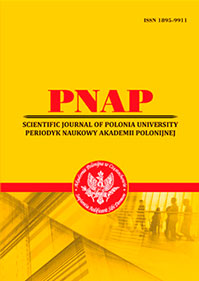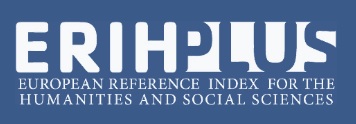THE ROLE OF INTONATION IN EMPHASIZING OF SEMANTICALLY IMPORTANT SPEECH UNITS (ON THE SAMPLES FROM MODERN ENGLISH FILM DISCOURSE)
Abstract
The article is a contribution to defining intonation means that emphasize semantically important speech units. To meet the aim identified above, data has been selected from film discourse which is seen as a verbal film component combined with its audiovisual line and other relevant extralinguistic factors. Film dialogue as a component of film discourse is a structural linear pattern, which is strictly determined, stable, time-ordered, characteristic of verbal and visual components and predictable. Intonation-prosodic arrangement of a dialogue is determined by its pragmatic intention, as well as peculiarities of compositional and logico-semantic structure. The analysis of the combination of pre-nuclear and nuclear components allows to identify certain typical melodic patterns marking semantically important pieces of information. The former have been defined as the combination of high level head with high falling or falling-rising tone, which is typical for most sense groups of the theme. As for the logical arrangement, this pattern expresses the sequence of actions, cause and effect relationship, it initiates a new topic and attracts the listener’s attention. Stable perceptive emphasis is gained by discourse components framed by the combination of descending, scandent, sliding, or broken descending heads with high or mid falling tones. Intonation emphasis of the sense groups manifesting the rheme is also performed by descending or falling heads. They highlight those parts of sense groups which are important for the rheme realization and frame conclusions, arguments, causeeffect relations. Descending heads often start a new discourse microtopic, creating certain rhythm for the highlighted phrases. The carried out instrumental analysis of emphatic communicative means has been helpful to prove that the emphasis of the most semantically important speech fragments is manifested by raising the pitch, widening the speech range, increasing the intensity, quickening the speech tempo, using meaningful pauses in front of semantically important word units.
References
2. Бігунова Н.О. Позитивна оцінка : від когнітивного судження до комунікативного висловлювання : монографія. Одеса : КП ОМД, 2017. 580 с.
3. Блохина Л.П. О роли просодических средств в организации устных текстов. Функциональная просодия текста : Сб. науч.тр. Москва, 1982. Вып. 201. С. 52–64.
4. Горшкова В.Е. Перевод в кино : монография. Иркутск : ИГЛУ, 2006. 278 с.
5. Горячева Н.Ю. Некоторые особенности реализации просодической категории выделенности в спонтанном звучащем тексте : дис. … канд. филол. наук : 10.02.04. Москва, 1999. 187 с.
6. Григорьев Е.И., Евтеев С.В. Влияние интонации речи на формирование концепта «угроза» (экспериментально-фонетическое исследование на материале современного немецкого языка) : монография. Москва : Издательство РГСУ, 2017. 136 с.
7. Дубовский Ю.А. Анализ интонации устного текста и его составляющих. Минск : Вышейшая школа, 1978. 153 с.
8. Зарецкая А.Н. Особенности реализации подтекста в кинодискурсе : дис. … канд. филол. наук : 10.02.19. Челябинск, 2010. 180 с.
9. Захватова Е.А. Риторическая функция интонации сценического монолога : автореф. дис. ... канд. филол. наук :10.02.19. Иваново, 2016. 25 с.
10. Златоустова Л.В., Надеина Т.М. Просодические средства выделения слова во фразе. Экспериментальная фонетика. Москва : Наука, 1989, 175 с.
11. Ковалев Ю.В. Прагматическая функция интонации в публичной политической речи : автореф. дис. ... докт. филол. наук :10.02.01. Москва, 2008. 45 с.
12. Кодзасов С.В. Уровни, единицы и процессы в интонации. Проблемы фонетики. Москва : Наука, 1999. № 3. С. 197–216.
13. Колодина Е.А. Взаимодействие семиотических систем при формировании смысла кинодиалога : дис. ... канд. филол. наук : 10.02.19. Иркутск, 2013. 168 с.
14. Метлюк А.А. Взаимодействие просодических систем в речи билингва : учебное пособие. Минск : Вышейшая школа, 1986. 112 с.
15. Надеина Т.М. Просодические средства как факторы речевого воздействия. Фонетика сегодня. Материалы докладов и сообщений V Международной научной конференции. Москва : Институт русского языка им. В.В. Виноградова РАН. 2007. С. 140–142.
16. Николаева Т.М. От звука к тексту. Москва : Языки славянской культуры, 2000. 680 с.
17. Павловская И.Ю. Фоносемантические аспекты речевой деятельности : дис. … докт. филол. наук : 10.02.04. Санкт-Петербург, 1999. 393 с.
18. Потапова Р.К. Речь: коммуникация, информация, кибернетика. Москва : Радио и связь, 1997. 528 с.
19. Прокофьева О.Г. Семантика интонационной выделенности в текстах спонтанной монологической речи : дис. … канд. филол. наук : 10.02.04. Москва, 2000. 196 с.
20. Торсуева И.Г. Интонация и смысл высказывания. Москва : Наука, 1979. 111 с.
21. Фрейдина Е.Л. Риторическая функция просодии: на материале британской академической публичной речи : дис. ... д-ра филол. наук : 10.02.04. Москва, 2005. 407 с.
22. Хромов С.С. Интонация как универсалия. Вестник ВГУ Языкознание. Серия 2. Волгоград, 2013. № 1 (17). С. 84–91.
23. Bolinger D. Intonation and its uses. Melody in grammar and discourse. Stanford, California, 1989. 278 p.
24. Cruttenden A. Intonation. 2nd ed. Cambridge : CUP, 1997. 205 p.
25. Crystal D. The English tone of voice. London, 1975. 224 p.
26. Donzel van. Prosodic aspects of information structure in discourse. Amsterdam, 1999. 195 p.
27. Kozloff S. Overhearing Film Dialogue. Berkeley & Los Angeles : University of California Press, 2000. 323 p.
28. Hirst D., Cristo A. Intonation Systems. Cambridge : CUP, 1998. 489 p.
 ISSN
ISSN 


.png)



